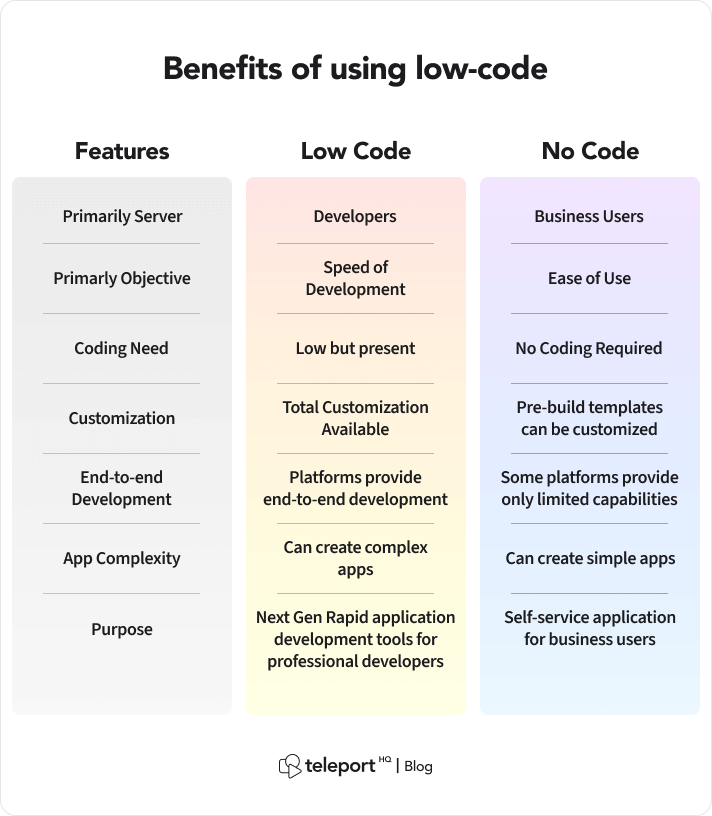Top Info For Selecting Low-Code Platform Info
Top Info For Selecting Low-Code Platform Info
Blog Article
Low-Code App Development Is Faster.
Visual Development Environment:
Drag-and-Drop Interfaces: Low-code platforms provide visual tools for designing applications. Developers can utilize drag-and-drop tools to create applications quickly and without having to write a lot of code.
Pre-built Templates and Components Many low-code platforms come with templates and components that are pre-built, that allow developers to quickly create and prototype applications without having to start from starting from scratch.
Reduced Coding Requirements
Automated Coding Generation Low code platforms automatically generate code using the visual model designed by the developers. This helps reduce the need for manual code coding and accelerates the development process.
Reusable Components: Developers can make use of reusable components across various projects, which reduces the amount of time they spend creating and testing code.
Collaboration Streamlined:
Integrated Development Tools: Low code platforms typically include tools for testing as well as deployment, version control and. They help facilitate collaboration between teams.
Citizen Development Developers, business users and other stakeholders can all participate in application development by using user-friendly interfaces. This eliminates the bottleneck caused by the absence of skilled developers.
Rapid Iteration, Prototyping:
Rapid Prototyping Developers are able to quickly build prototypes for ideas to be validated and feedback to be gathered which results in faster iteration.
Simple Modifications. Low-code development's visual nature allows users to modify and upgrade their apps.
Pre-built Integrations:
API Integrations Low-code platforms include already built connectors that can be used with APIs or services that are popular. They reduce the time it takes to connect external applications.
Data Integration: The built-in tools facilitate the process of connecting with databases and other sources, accelerating development.
Scaling and deployment:
One-Click deployment: A lot of platforms that make use of low-code have a one-click option for deploying applications, which can reduce time and effort.
Cloud-Based Platforms: Cloud-based platforms which are low-code can manage infrastructure and scaling, so developers can concentrate on the logic and functionality of applications rather than the logistics of deployment.
Low-code application development is a quicker method to develop applications. It streamlines and automates many aspects of the process. This enables faster development and the ability to adapt to evolving requirements. Follow the top rated read this post here for Low-code Platform for application development for site advice including developing mobile apps, push alerts, rad application development, push notifications android, develop web application, low code platforms, rad application development, application modernization software, lowcode no code, rapid applications and more.
Benefits Of Developing Applications Using Low-Code In Terms Of Scalability And Flexibility
Low-code application development has many advantages when it comes to adaptability and scalability, which are essential for creating applications that are able to adapt to business demands and adapt to changing requirements. Here are three key benefits.
Cloud-Based Deployment: Many low-code applications are cloud-based, enabling applications to scale seamlessly with the underlying cloud infrastructure. Businesses can handle greater load without having to worry too much about administration of servers.
Auto-Scaling: The auto-scaling feature will automatically adjust the resources based on the demands. This ensures the same performance even during peak hours with no manual intervention.
Flexible Architecture:
Low-code platforms encourage modular design where components can independently be developed, assessed and adapted. This modularity enhances flexibility and allows to upgrade or expand certain parts of an application without impacting the overall system.
Microservices Integration: Microservices Architecture support lets applications to be constructed by combining loosely coupled services, which improves the scalability as well as flexibility.
Customizable Solutions:
Flexibility : Low-code platforms enable developers to expand functions beyond what they are able to provide. This allows businesses to satisfy the requirements of their particular business.
Third-Party Integrations: Businesses may integrate additional functionality and features into their applications through APIs and other third-party services.
Agile Development and Deployment
Continuous Delivery and Deployment Low-Code Platforms facilitate agile methods by enabling continuous Integration and Continuous Delivery (CI/CD). This allows rapid deployment and updating of new features.
Iterative development low-code development is an iterative process, which means applications can be adapted and improved gradually. This reduces the risk of massive changes, while also allowing the growth to be controlled.
Resource Optimization
Effective Resource Management: Low-code platforms help optimize the usage of resources through providing tools for monitoring and managing application performance. This helps ensure that resources are used efficiently. They are also able to be scaled-up or reduced in accordance with the actual requirements.
Load-balancing: Features that distribute workloads equally across servers enhance the capacity of applications to handle large traffic and ensure consistent performance.
Global Reach:
Multi-Region availability: Lowcode platforms permit for deployment across multiple regions. Businesses can provide users low-latency access to the world. This is especially important when it comes to applications that have a worldwide user base.
Localization Support The built-in support for language localization lets applications easily adapt to various languages and regional requirements which allows them to adapt to various markets.
Maintenance and updates
Simple Maintenance: The aesthetic and modular nature of low-code programs simplify maintenance tasks which allows updates and bug fixes to be completed quickly and without a long period of downtime.
Version Control: The integrated versions control systems permit the secure deployment of rollbacks and updates. Previous versions can also be restored in the event that they're needed.
Cost Efficiency:
Low development costs. By reducing coding requirements, low-code platforms lower the cost of development and enable applications to scale up without increasing development efforts.
Pay-as-you-go models Many low-code platforms provide flexible pricing, such as the pay-asyou-go model, which aligns costs with actual usage and growth. This gives financial flexibility.
In the end, low-code application development gives businesses the flexibility and scalability that they need to build robust and flexible applications. These platforms can respond quickly to changes in requirements, resource efficiency, and continual improvements, making it possible for the development of applications to evolve as a company. Follow the recommended inquiry on Enterprise application development with Low-code Platform for website examples including no code platforms, sso azure, rad development, rapid application design, driver jdbc, cross platform mobile dev, cross platform mobile app development, azure sql server, application modernisation, cross platform mobile dev and more.
Benefits Of Low-Code Application Development In Terms Of Customization And Limitations
Low-code app development is a well-balanced solution that provides significant benefits in dealing with limitations and permitting customization. These are the major advantages: Handling Limitations
In overcoming Complexity Barriers:
Simplified development: Low code platforms make it easier to develop by providing templates and pre-built elements. This helps speed up application deployment, even for complicated ones.
Guided Workflows - Many platforms offer guided workflows or wizards that aid developers in navigating difficult procedures. This reduces the risk of making mistakes and guarantees the sameness of the process.
Scalability solutions:
Scalability is built into: Low-code platform often includes features that enable the development of scalable architecture. Applications are able to handle higher demands with little development.
Performance Monitoring: Integrated instruments for monitoring performance and optimization can to ensure that applications are effective as they expand.
Security and Compliance
Integrated Security Features: Low-code platforms come with built-in security measures such as encryption, access control based on role, and automated compliance checks to address security issues that are common.
Platforms are regularly updated with their security and compliance procedures to ensure that applications are safe from new threats.
Options for Customization:
Extensibility:
Low-code platforms permit developers to extend functionality beyond standard offerings by adding customized code.
Moduls and plugins that are custom-designed Developers are able to develop custom plug-ins and modules that have specific features tailored to the unique requirements of a business.
APIs and integration:
API Support: Full API support is available to facilitate seamless integration and connection with other systems.
Third-Party Services: Low-code platforms typically have pre-built connectors to popular third-party services, making it simpler to connect and modify applications.
Flexible UX/UI Designs:
Flexible User Interfaces for Developers: Designers can modify and design user interfaces that meet specific specifications for branding and usability and provide a customized user experience.
Responsive Web Design: Built-in design responsive capabilities permit applications to be tailored depending on the size of the screen and the device.
Business Logic Customization:
Visual Workflow Designers: These graphic tools allow you to modify and create workflows and business logic, allowing programmers to create complex tailored processes.
Platforms offer conditional logic to meet specific business rules or scenarios.
Data Management
Custom Data Modelling: Those who develop the models develop custom models to meet specific application needs. They can tailor the handling of data to meet business specifications.
Advanced Data Processing: Integration of advanced tools and capabilities for data processing permits customization of the way that data is analysed and utilized within the application.
Balance Customization and Limitations
Frameworks and Standards:
Best Practices: Low-code platform encourages adherence to standards and industry best practices. This is helpful in maintaining high-quality, scalable and secured applications.
Governance Frameworks: Integrated governance frameworks ensure that the customizations do not interfere with the integrity, conformity, or security of the application.
Iterative Development:
Rapid Prototyping. The capability of quickly prototype and test modifications allows developers to iterate the application based on user feedback. This helps to refine the app to better meet users' needs.
Continuous Improvement: Platforms with low-code support continuous improvements that allow customization and enhancement when the requirements of business evolve.
Empowering Users:
Giving Citizen Developers the ability to be empowered: By giving non-developers the ability to modify their applications using intuitive interfaces as well as low-code platforms, they can increase the number of contributors who are able to enhance and tailor application.
Support and training: A lot of platforms provide extensive training resources as well as support services to help users in creating customizations that are effective without compromising the application's performance or stability.
Overall, low-code application development provides a solid framework for addressing limitations and offers a wide range of possibilities to customize. This allows businesses to create and maintain applications that are customized and functional to meet their specific requirements while maintaining high levels of safety, quality, and scaling.